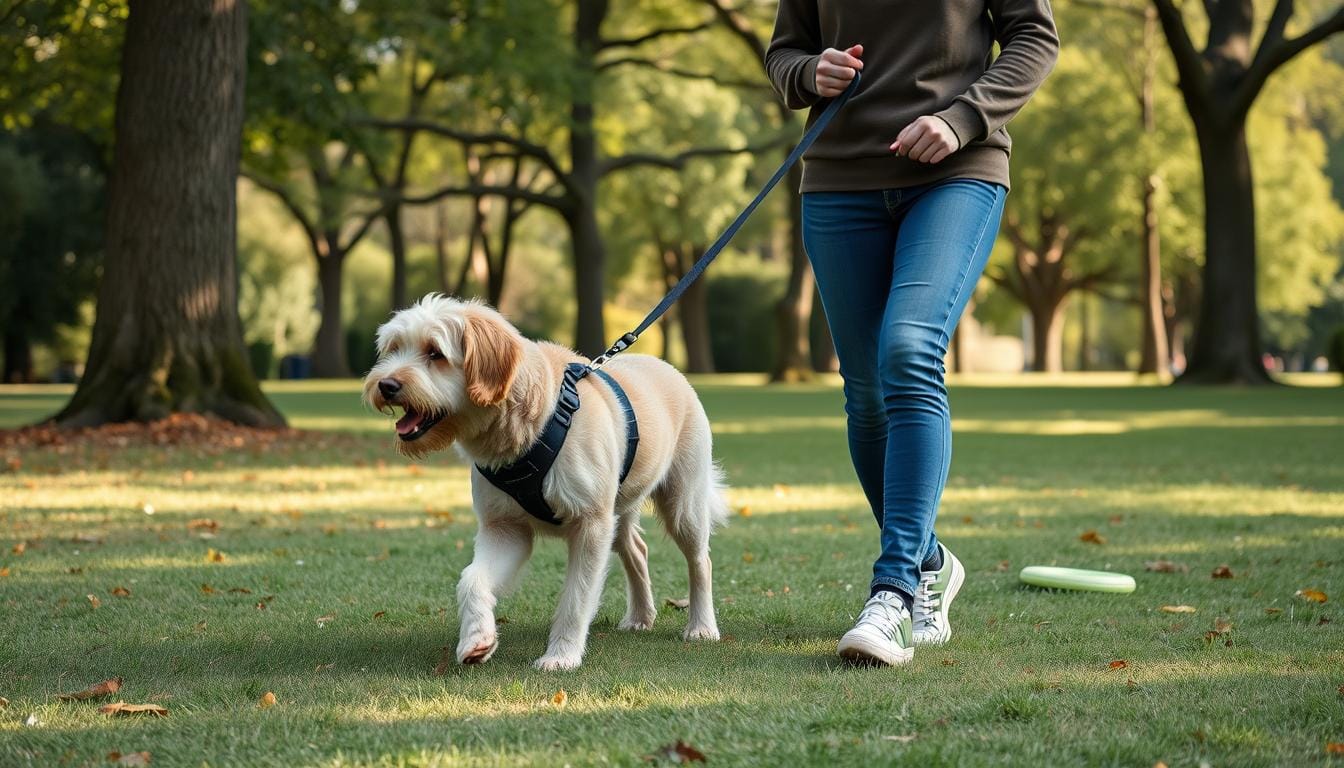Dogs can sense human emotions instinctively. They read our facial expressions and body language. This skill comes from their long bond with humans.
They use this emotional intelligence to communicate with us. Often, they anticipate our needs before we do.
We must watch our dogs’ health, especially for urinary tract infections (UTIs). These infections can cause discomfort and serious problems if not treated. Let’s look into when home remedies can help and when to see a vet.
Key Takeaways
- Up to 27% of dogs may develop a UTI in their lifetime
- Female dogs are more prone to UTIs due to their anatomy
- Common symptoms include frequent urination and blood in urine
- Bacterial infections are a primary cause of dog UTIs
- Home remedies can help, but veterinary care is crucial for severe cases
- Proper hydration and diet play key roles in preventing UTIs
- Antibiotic resistance is a growing concern in treating canine UTIs
Urinary tract infections in dogs are more common than many pet owners think. Up to 27% of dogs get a UTI at some point. It’s key to know the signs and how to act.
While home remedies can help mild cases, sometimes a vet is needed. This ensures your dog stays healthy and happy.
Understanding Dog UTIs: Causes and Symptoms
Dog urinary tract infections (UTIs) are common in many dogs. We’ll look at what causes dog UTIs, the symptoms, and risk factors. This will help you care for your dog better.
Common Causes of Urinary Tract Infections in Dogs
Most dog UTIs come from bacteria. E. coli is the main cause. Other reasons include:
- Bladder stones
- Diabetes
- Kidney disease
- Spinal cord issues
Recognizing UTI Symptoms in Your Canine Companion
Spotting UTI symptoms early is key. Look for these signs:
- Frequent urination
- Straining during urination
- Blood in urine
- Strong odor in urine
- Accidents in house-trained dogs
- Excessive licking of genital area
Risk Factors for Developing UTIs in Dogs
Knowing the risk factors can help prevent UTIs. Important factors include:
- Gender: Female dogs are more prone due to shorter urethras
- Age: Senior dogs (7+ years) are at higher risk
- Breed: Some breeds like Shih Tzu and Yorkshire Terrier are predisposed
- Health conditions: Diabetes increases susceptibility
- Anatomical issues: Excess vulvar tissue raises infection risk
By understanding these factors, you can keep your dog’s urinary system healthy. Also, seek vet care when needed.
The Importance of Proper Hydration for Urinary Health
Keeping your dog hydrated is key to their urinary health and avoiding UTIs. It’s important to make sure they drink enough water each day. A good rule is to give them one ounce of water for every pound of their body weight.
Watching how much water your dog drinks helps you know what they need. Drinking enough water can help prevent dog UTI and lower the chance of urinary stones. Signs of dehydration include being very tired, having a dry mouth, and their skin not bouncing back when pressed.
To help your dog drink more water, try these ideas:
- Change their water often
- Use a water fountain to make it more fun
- Add a little low-sodium broth to their water
- Try wet food to add moisture
Watching how much water your dog drinks can help spot health problems early. If you see any changes in their water intake or signs of dehydration, see a vet right away.
| Water Intake Benefits | Dehydration Risks |
|---|---|
| Prevents UTIs | Lethargy |
| Reduces urinary stones | Dry mouth |
| Maintains overall health | Loss of appetite |
| Supports kidney function | Sunken eyes |
By focusing on proper hydration, we can greatly improve our dogs’ urinary health and overall health. Always keep water available to keep your dog happy and healthy.
Dietary Changes to Support Dog Urinary Health
A dog’s diet is key to preventing and managing UTIs. We’ll look at important dietary changes that can help your furry friend’s urinary health.
Incorporating Cranberries and Blueberries into Your Dog’s Diet
Cranberries are becoming popular for preventing dog UTIs. They contain mannose, which stops bacteria from sticking to the urinary tract walls. Blueberries also help reduce UTI risk. You can add small amounts of these berries to your dog’s food or offer them as treats.
The Role of Probiotics in Preventing UTIs
Probiotics for dogs are beneficial bacteria that support gut health and boost the immune system. They create an environment that’s unfriendly to harmful bacteria, potentially reducing UTI occurrences. You can find probiotic supplements or foods with added probiotics designed specifically for canines.
Avoiding Foods That May Exacerbate UTI Symptoms
Some foods can worsen UTI symptoms in dogs. Avoid spinach, asparagus, tomatoes, raw carrots, and dairy products if your dog is prone to UTIs. These foods can increase urine alkalinity, creating a favorable environment for bacteria growth.
| Beneficial Foods | Foods to Avoid |
|---|---|
| Cranberries | Spinach |
| Blueberries | Asparagus |
| Probiotic-rich foods | Tomatoes |
| High-quality proteins | Raw carrots |
| Omega-3 rich foods | Dairy products |
Remember, before making significant changes to your dog’s diet, consult with your veterinarian. They can provide personalized advice based on your dog’s specific health needs and help you create the best dog urinary health diet plan.
Natural Supplements for Dog UTI Prevention and Treatment
Natural remedies for dog UTIs are becoming more popular. Dog UTI supplements use nature’s power and science to help. They offer a holistic way to keep your dog’s urinary system healthy.

Cranberry supplements are known to fight dog UTIs well. They have D-mannose, which stops bacteria from sticking to the urinary tract. Parsley leaf helps by promoting urination and getting rid of bad bacteria.
Other supplements that help include:
- Marshmallow root: Soothes inflammation
- Couch grass: Offers anti-inflammatory and antimicrobial benefits
- Vitamin C: Increases urine acidity, making it hard for bacteria to survive
Even though natural remedies are helpful, they shouldn’t replace vet care. Always talk to your vet before adding new supplements to your dog’s routine.
| Supplement | Benefits | Dosage |
|---|---|---|
| Cranberry | Prevents bacterial attachment | 100mg per 10 lbs body weight |
| Parsley Leaf | Antiseptic, promotes urination | 1/2 tsp per 20 lbs body weight |
| Marshmallow Root | Soothes inflammation | 1/4 tsp per 20 lbs body weight |
| Couch Grass | Anti-inflammatory, antimicrobial | 1/2 tsp per 30 lbs body weight |
Preventing UTIs is important. Make sure your dog drinks plenty of water. Give them regular breaks to go to the bathroom. Keeping them clean also helps their urinary health.
Hygiene Practices to Prevent Urinary Tract Infections
Keeping your dog clean is key to avoiding UTIs. By keeping them clean, we can lower the chance of bacterial infections. Let’s look at some good hygiene habits to stop dog UTIs.
Proper Grooming Techniques for Long-Haired Dogs
Long-haired dogs need more grooming to avoid UTIs. Trimming fur around their genital area keeps it clean and dry. This stops bacteria from growing. Use pet-safe wipes after they pee to cut down infection risk.
Maintaining a Clean Living Environment
A clean home is vital for your dog’s urinary health. Wash their bedding and clean their space often. This cuts down on harmful bacteria. It also boosts their overall health.
| Hygiene Practice | Frequency | Benefits |
|---|---|---|
| Genital area cleaning | Daily | Reduces bacterial entry |
| Fur trimming (long-haired dogs) | Monthly | Keeps area dry and clean |
| Bedding wash | Weekly | Minimizes bacterial exposure |
| Living area cleaning | Bi-weekly | Promotes overall hygiene |
By sticking to these hygiene tips, we can make a cleaner space for our dogs. This lowers their chance of getting UTIs. Remember, stopping UTIs early is the best way to keep your dog’s urinary system healthy.
The Benefits of Increased Bathroom Breaks
A good dog bathroom schedule is key to preventing UTIs. Dogs that pee often help flush out bad bacteria. This keeps their urinary tract healthy.

Dogs that hold their pee too long are at risk for UTIs. We should make sure they pee more often. This simple step can help a lot.
Here’s a sample schedule to promote healthy urination habits:
- Early morning: First bathroom break of the day
- Mid-morning: Quick potty break
- Lunchtime: Longer walk with multiple opportunities to urinate
- Mid-afternoon: Another quick break
- Evening: Walk and bathroom time
- Before bed: Final chance to empty the bladder
Following this schedule helps dogs pee often, which is good for UTI prevention. Remember, every dog is different. Adjust the schedule to fit your dog’s needs and your daily life.
“Regular bathroom breaks are a simple yet effective way to maintain your dog’s urinary health and prevent UTIs.”
By making these changes, we can make our dogs happier and healthier. They’ll have fewer urinary problems. Let’s make sure our pets have plenty of chances to pee throughout the day.
Dog UTI: Home Remedies vs. Veterinary Treatment
Dealing with UTIs in dogs can be challenging. Home remedies might work for mild cases, but severe infections need a vet’s help. It’s important to know when to try home treatments and when to see a vet.
When Home Remedies Are Appropriate
For mild UTI symptoms, home remedies can be a good start. You can try increasing your dog’s water intake, changing their diet, and using natural supplements. Since about 14% of dogs get UTIs, knowing how to handle mild cases at home is crucial.
- Increase water intake to flush out bacteria
- Add cranberry supplements to your dog’s diet
- Provide probiotic-rich foods to boost gut health
Signs That Indicate a Vet Visit Is Necessary
Even though home remedies can help, knowing when to see a vet is key. If symptoms don’t get better or get worse after a few days, it’s time to get professional help. Vets are especially important for complicated UTIs, which might need 3 to 6 weeks of treatment.
Signs that mean you should see a vet right away include:
- Fever or lethargy
- Blood in urine
- Difficulty urinating or inability to urinate
- Persistent symptoms after trying home remedies
Remember, quick treatment is vital to avoid complications. If you’re not sure about your dog’s health, always talk to a vet for the right diagnosis and care.
Over-the-Counter UTI Treatments for Dogs: Pros and Cons
OTC dog UTI treatments are a quick fix for pet owners. They often include antibiotics and vitamin B supplements. These can help treat urinary tract infections. They’re easy to find, which is great when you can’t get to the vet right away.
These medications can make your dog feel better fast. Many owners see improvements in 24 to 48 hours. This is especially helpful for dogs in pain from UTIs.
But, OTC treatments have their limits. Without a vet’s diagnosis, we might not catch all issues. A urine test is the best way to confirm a UTI and find the right treatment.
| Pros of OTC UTI Treatments | Cons of OTC UTI Treatments |
|---|---|
| Convenient and accessible | May not address underlying causes |
| Quick symptom relief | Risk of antibiotic resistance |
| Cost-effective (often $35-$75) | Potential for misdiagnosis |
| Immediate action possible | May not be suitable for chronic UTIs |
While OTC treatments are helpful, they shouldn’t replace vet care. For long-term or complex UTIs, a vet is needed. Always talk to a vet before starting any new treatment for your dog’s urinary health.
The Role of Apple Cider Vinegar in Dog Urinary Health
Apple cider vinegar is becoming popular as a natural way to treat UTIs in dogs. It’s a versatile ingredient that can help with dog wellness, especially in urinary health.
Proper Dosage and Administration Methods
It’s important to get the right amount of apple cider vinegar for dogs. Medium-sized dogs need 2-3 teaspoons a day. Mix it with food or water at a 1:3 ratio to avoid upsetting their stomach.
For using it on the skin, dilute the vinegar in a 1:10 ratio with water. This can help keep the skin’s pH balanced and fight off bacteria. Some pet owners mix it 50/50 with water for bladder infections, but always check with your vet first.
Potential Benefits and Risks
Apple cider vinegar can help fight bacteria in the urinary tract, which might prevent UTIs. It can also help with digestion and nutrient absorption. In a survey, 93% of users found it very effective for their dogs.
| Benefit | Risk |
|---|---|
| Balances urinary pH | Overuse can cause stomach upset |
| Repels fleas and ticks | May interact with certain medications |
| Supports digestive health | Not suitable for all dogs |
While apple cider vinegar is helpful, it’s not a solution for everything. Always make sure your dog gets regular vet check-ups for their overall health. Remember, natural remedies should help, not replace, professional vet care.
Herbal Remedies for Canine Urinary Tract Health
We often look for herbal remedies for dog UTIs to help our furry friends. Nature has many herbs that support a healthy urinary tract in dogs. Uva ursi fights off UTI-causing germs with its antimicrobial powers.
Marshmallow root soothes the urinary tract and boosts the immune system. This helps dogs with UTIs in two ways. It’s a natural way to keep their urinary system healthy.
Juniper berry is also a strong ally against UTIs. It has antibacterial and antifungal properties. As a diuretic, it helps clear out infections, keeping dogs’ urinary systems healthy.
While herbal remedies are helpful, we must be careful. Not all herbs are safe for every dog, especially those with kidney or liver problems. Pregnant or nursing dogs might also react differently to certain herbs.
Before starting any herbal treatment, it’s important to talk to a vet. They can make sure the remedy is safe and right for your dog’s needs.
















